MIS603: Microservice Architecture for Business Operations Analysis
VerifiedAdded on 2022/09/10
|13
|3587
|14
Report
AI Summary
This report provides an executive summary and detailed analysis of microservice architecture, a technique for developing software systems using single-function modules with defined interfaces. It evaluates the benefits and challenges of integrating microservice architecture with business operations, focusing on companies like Uber, Netflix, and Amazon. The report explores the advantages such as improved application performance and scalability, and the challenges including communication complexities and security issues. It also examines service modeling principles, including SOAP, XML-RPC, and REST, and discusses challenges in splitting monolithic systems. The report concludes with recommendations for enhancing security and managing communication issues, emphasizing the importance of encryption, firewalls, and appropriate communication protocols to mitigate risks and ensure efficient business operations. Ethical, legal and security issues related to microservice architectures are also covered.

IT 0
Micro-service Architecture
Micro-service Architecture
Paraphrase This Document
Need a fresh take? Get an instant paraphrase of this document with our AI Paraphraser
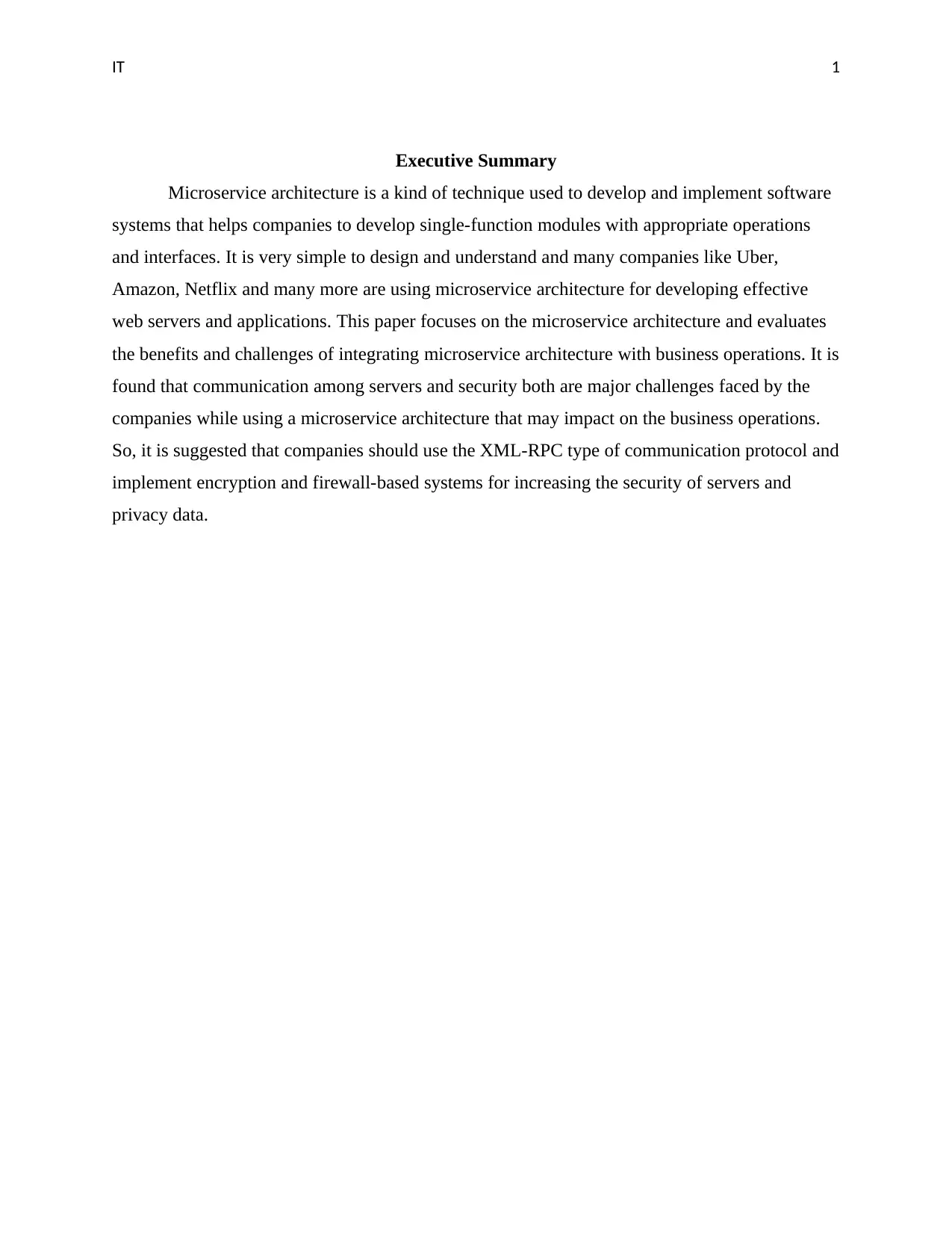
IT 1
Executive Summary
Microservice architecture is a kind of technique used to develop and implement software
systems that helps companies to develop single-function modules with appropriate operations
and interfaces. It is very simple to design and understand and many companies like Uber,
Amazon, Netflix and many more are using microservice architecture for developing effective
web servers and applications. This paper focuses on the microservice architecture and evaluates
the benefits and challenges of integrating microservice architecture with business operations. It is
found that communication among servers and security both are major challenges faced by the
companies while using a microservice architecture that may impact on the business operations.
So, it is suggested that companies should use the XML-RPC type of communication protocol and
implement encryption and firewall-based systems for increasing the security of servers and
privacy data.
Executive Summary
Microservice architecture is a kind of technique used to develop and implement software
systems that helps companies to develop single-function modules with appropriate operations
and interfaces. It is very simple to design and understand and many companies like Uber,
Amazon, Netflix and many more are using microservice architecture for developing effective
web servers and applications. This paper focuses on the microservice architecture and evaluates
the benefits and challenges of integrating microservice architecture with business operations. It is
found that communication among servers and security both are major challenges faced by the
companies while using a microservice architecture that may impact on the business operations.
So, it is suggested that companies should use the XML-RPC type of communication protocol and
implement encryption and firewall-based systems for increasing the security of servers and
privacy data.
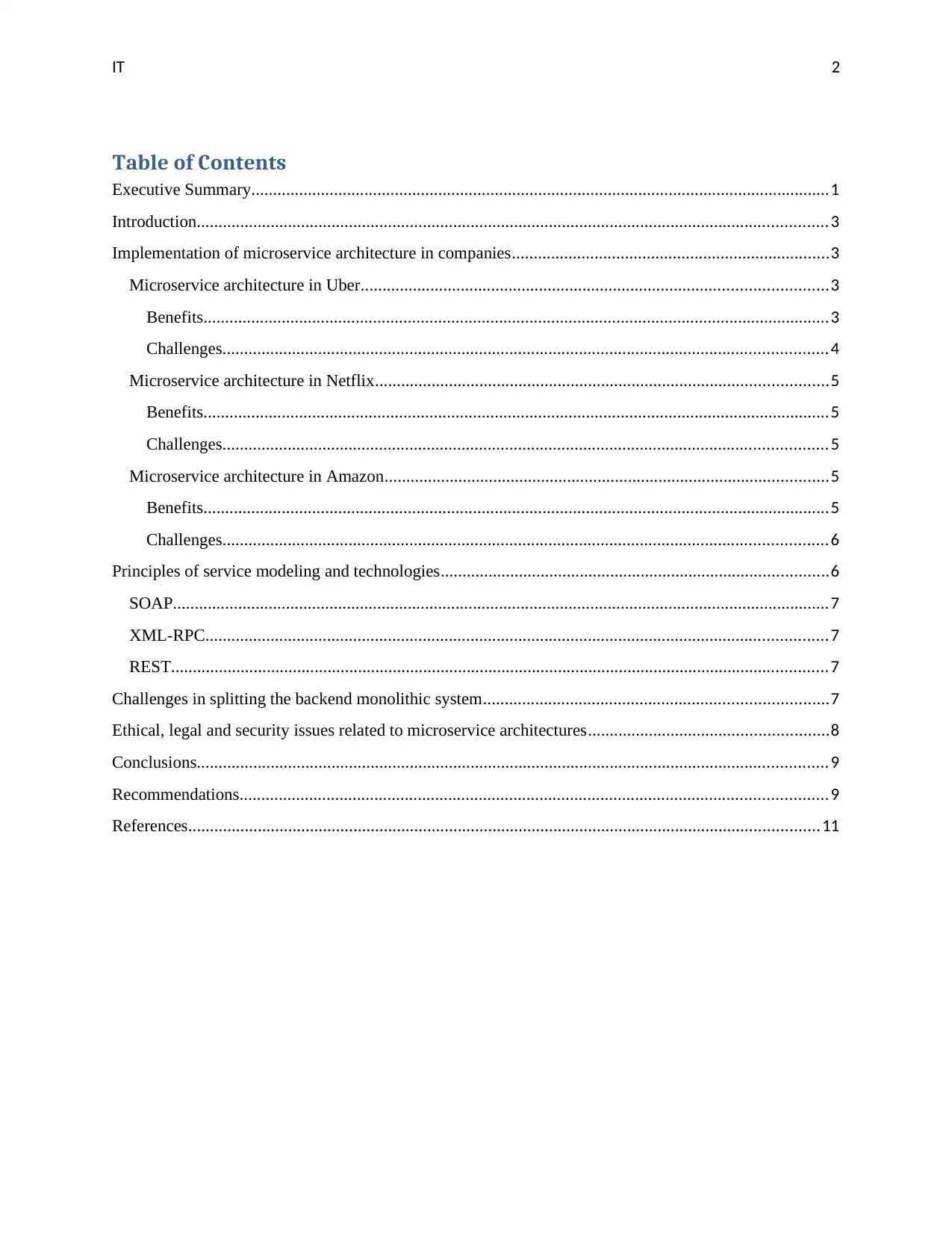
IT 2
Table of Contents
Executive Summary.....................................................................................................................................1
Introduction.................................................................................................................................................3
Implementation of microservice architecture in companies.........................................................................3
Microservice architecture in Uber...........................................................................................................3
Benefits................................................................................................................................................3
Challenges...........................................................................................................................................4
Microservice architecture in Netflix........................................................................................................5
Benefits................................................................................................................................................5
Challenges...........................................................................................................................................5
Microservice architecture in Amazon......................................................................................................5
Benefits................................................................................................................................................5
Challenges...........................................................................................................................................6
Principles of service modeling and technologies.........................................................................................6
SOAP.......................................................................................................................................................7
XML-RPC...............................................................................................................................................7
REST.......................................................................................................................................................7
Challenges in splitting the backend monolithic system...............................................................................7
Ethical, legal and security issues related to microservice architectures.......................................................8
Conclusions.................................................................................................................................................9
Recommendations.......................................................................................................................................9
References.................................................................................................................................................11
Table of Contents
Executive Summary.....................................................................................................................................1
Introduction.................................................................................................................................................3
Implementation of microservice architecture in companies.........................................................................3
Microservice architecture in Uber...........................................................................................................3
Benefits................................................................................................................................................3
Challenges...........................................................................................................................................4
Microservice architecture in Netflix........................................................................................................5
Benefits................................................................................................................................................5
Challenges...........................................................................................................................................5
Microservice architecture in Amazon......................................................................................................5
Benefits................................................................................................................................................5
Challenges...........................................................................................................................................6
Principles of service modeling and technologies.........................................................................................6
SOAP.......................................................................................................................................................7
XML-RPC...............................................................................................................................................7
REST.......................................................................................................................................................7
Challenges in splitting the backend monolithic system...............................................................................7
Ethical, legal and security issues related to microservice architectures.......................................................8
Conclusions.................................................................................................................................................9
Recommendations.......................................................................................................................................9
References.................................................................................................................................................11
⊘ This is a preview!⊘
Do you want full access?
Subscribe today to unlock all pages.

Trusted by 1+ million students worldwide
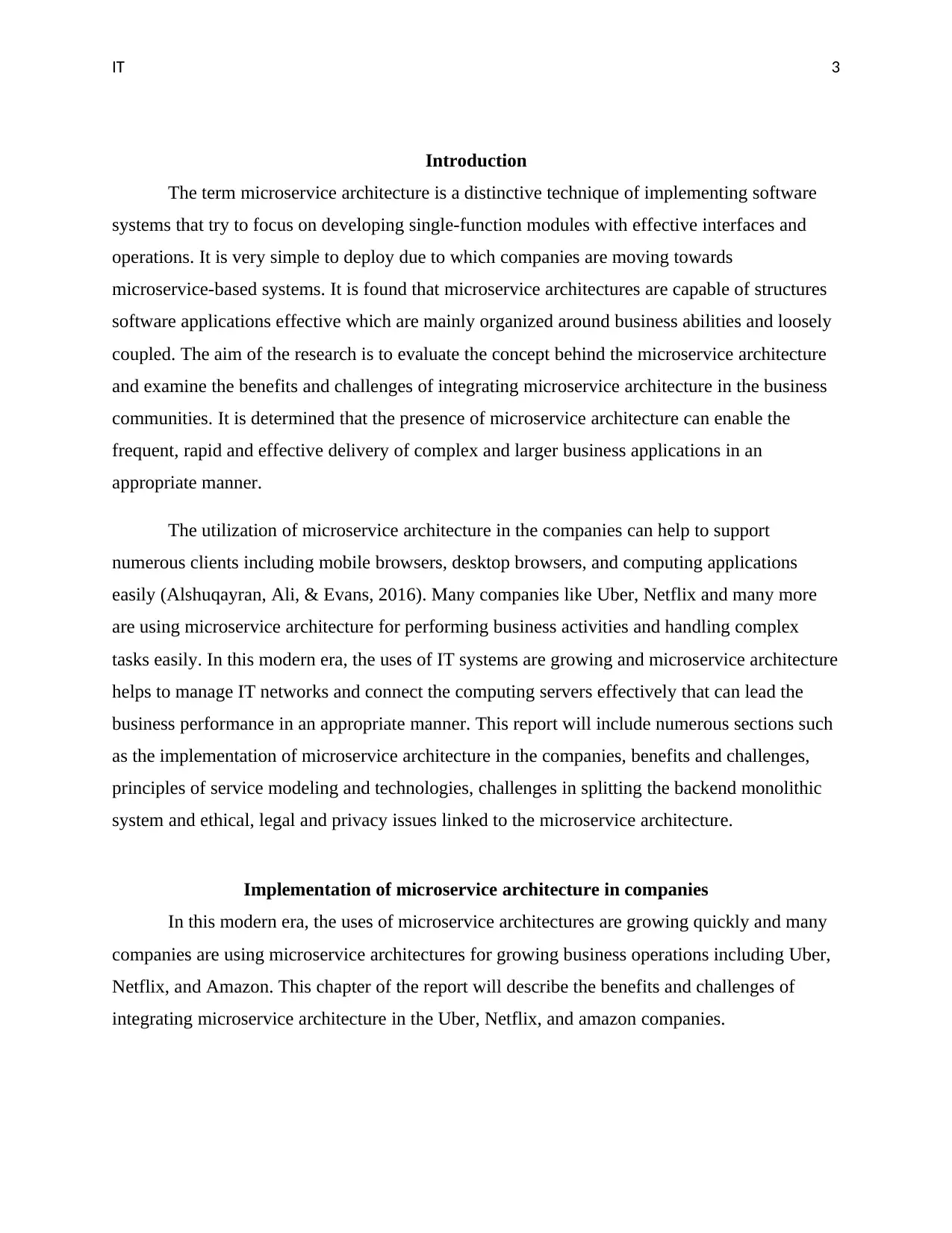
IT 3
Introduction
The term microservice architecture is a distinctive technique of implementing software
systems that try to focus on developing single-function modules with effective interfaces and
operations. It is very simple to deploy due to which companies are moving towards
microservice-based systems. It is found that microservice architectures are capable of structures
software applications effective which are mainly organized around business abilities and loosely
coupled. The aim of the research is to evaluate the concept behind the microservice architecture
and examine the benefits and challenges of integrating microservice architecture in the business
communities. It is determined that the presence of microservice architecture can enable the
frequent, rapid and effective delivery of complex and larger business applications in an
appropriate manner.
The utilization of microservice architecture in the companies can help to support
numerous clients including mobile browsers, desktop browsers, and computing applications
easily (Alshuqayran, Ali, & Evans, 2016). Many companies like Uber, Netflix and many more
are using microservice architecture for performing business activities and handling complex
tasks easily. In this modern era, the uses of IT systems are growing and microservice architecture
helps to manage IT networks and connect the computing servers effectively that can lead the
business performance in an appropriate manner. This report will include numerous sections such
as the implementation of microservice architecture in the companies, benefits and challenges,
principles of service modeling and technologies, challenges in splitting the backend monolithic
system and ethical, legal and privacy issues linked to the microservice architecture.
Implementation of microservice architecture in companies
In this modern era, the uses of microservice architectures are growing quickly and many
companies are using microservice architectures for growing business operations including Uber,
Netflix, and Amazon. This chapter of the report will describe the benefits and challenges of
integrating microservice architecture in the Uber, Netflix, and amazon companies.
Introduction
The term microservice architecture is a distinctive technique of implementing software
systems that try to focus on developing single-function modules with effective interfaces and
operations. It is very simple to deploy due to which companies are moving towards
microservice-based systems. It is found that microservice architectures are capable of structures
software applications effective which are mainly organized around business abilities and loosely
coupled. The aim of the research is to evaluate the concept behind the microservice architecture
and examine the benefits and challenges of integrating microservice architecture in the business
communities. It is determined that the presence of microservice architecture can enable the
frequent, rapid and effective delivery of complex and larger business applications in an
appropriate manner.
The utilization of microservice architecture in the companies can help to support
numerous clients including mobile browsers, desktop browsers, and computing applications
easily (Alshuqayran, Ali, & Evans, 2016). Many companies like Uber, Netflix and many more
are using microservice architecture for performing business activities and handling complex
tasks easily. In this modern era, the uses of IT systems are growing and microservice architecture
helps to manage IT networks and connect the computing servers effectively that can lead the
business performance in an appropriate manner. This report will include numerous sections such
as the implementation of microservice architecture in the companies, benefits and challenges,
principles of service modeling and technologies, challenges in splitting the backend monolithic
system and ethical, legal and privacy issues linked to the microservice architecture.
Implementation of microservice architecture in companies
In this modern era, the uses of microservice architectures are growing quickly and many
companies are using microservice architectures for growing business operations including Uber,
Netflix, and Amazon. This chapter of the report will describe the benefits and challenges of
integrating microservice architecture in the Uber, Netflix, and amazon companies.
Paraphrase This Document
Need a fresh take? Get an instant paraphrase of this document with our AI Paraphraser
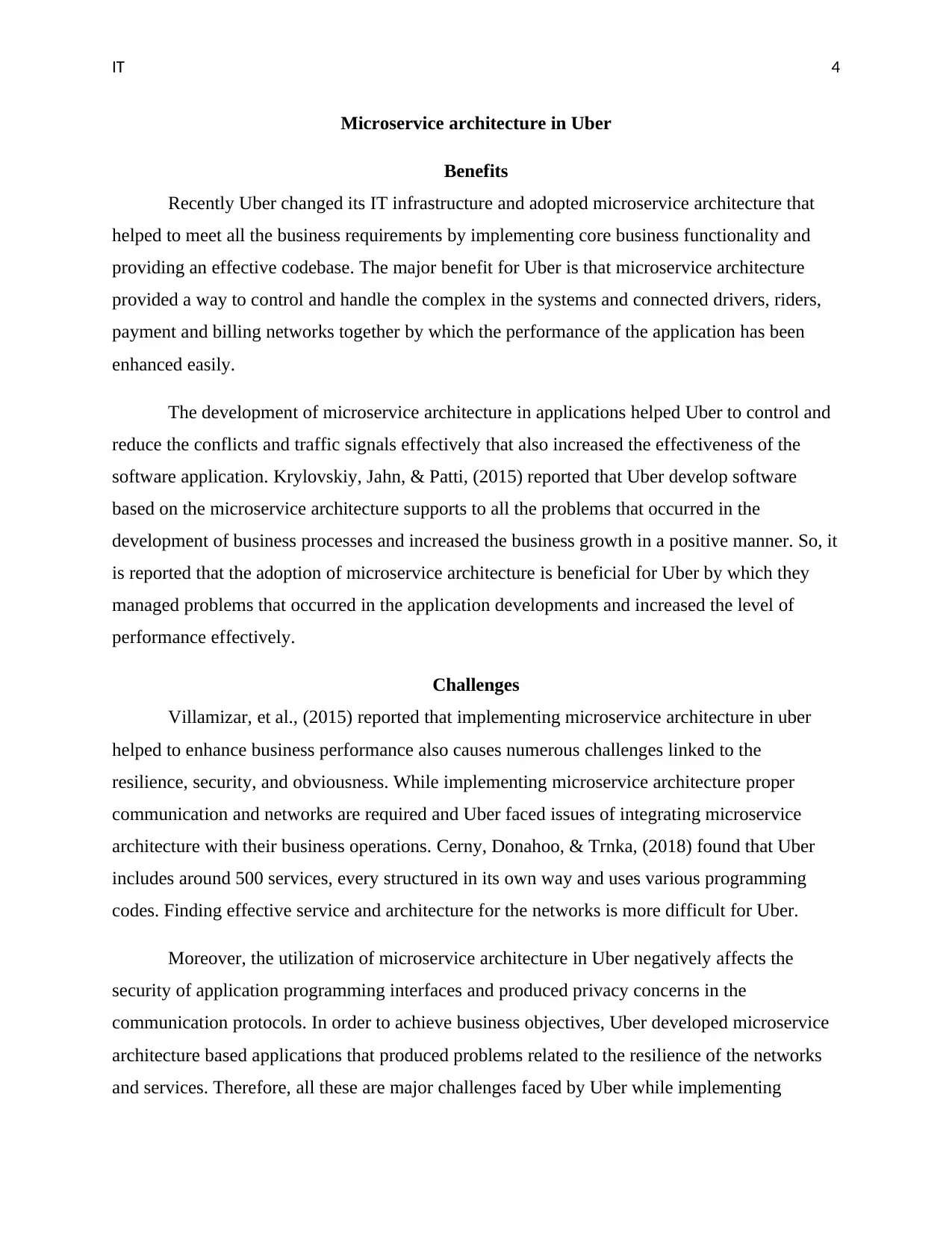
IT 4
Microservice architecture in Uber
Benefits
Recently Uber changed its IT infrastructure and adopted microservice architecture that
helped to meet all the business requirements by implementing core business functionality and
providing an effective codebase. The major benefit for Uber is that microservice architecture
provided a way to control and handle the complex in the systems and connected drivers, riders,
payment and billing networks together by which the performance of the application has been
enhanced easily.
The development of microservice architecture in applications helped Uber to control and
reduce the conflicts and traffic signals effectively that also increased the effectiveness of the
software application. Krylovskiy, Jahn, & Patti, (2015) reported that Uber develop software
based on the microservice architecture supports to all the problems that occurred in the
development of business processes and increased the business growth in a positive manner. So, it
is reported that the adoption of microservice architecture is beneficial for Uber by which they
managed problems that occurred in the application developments and increased the level of
performance effectively.
Challenges
Villamizar, et al., (2015) reported that implementing microservice architecture in uber
helped to enhance business performance also causes numerous challenges linked to the
resilience, security, and obviousness. While implementing microservice architecture proper
communication and networks are required and Uber faced issues of integrating microservice
architecture with their business operations. Cerny, Donahoo, & Trnka, (2018) found that Uber
includes around 500 services, every structured in its own way and uses various programming
codes. Finding effective service and architecture for the networks is more difficult for Uber.
Moreover, the utilization of microservice architecture in Uber negatively affects the
security of application programming interfaces and produced privacy concerns in the
communication protocols. In order to achieve business objectives, Uber developed microservice
architecture based applications that produced problems related to the resilience of the networks
and services. Therefore, all these are major challenges faced by Uber while implementing
Microservice architecture in Uber
Benefits
Recently Uber changed its IT infrastructure and adopted microservice architecture that
helped to meet all the business requirements by implementing core business functionality and
providing an effective codebase. The major benefit for Uber is that microservice architecture
provided a way to control and handle the complex in the systems and connected drivers, riders,
payment and billing networks together by which the performance of the application has been
enhanced easily.
The development of microservice architecture in applications helped Uber to control and
reduce the conflicts and traffic signals effectively that also increased the effectiveness of the
software application. Krylovskiy, Jahn, & Patti, (2015) reported that Uber develop software
based on the microservice architecture supports to all the problems that occurred in the
development of business processes and increased the business growth in a positive manner. So, it
is reported that the adoption of microservice architecture is beneficial for Uber by which they
managed problems that occurred in the application developments and increased the level of
performance effectively.
Challenges
Villamizar, et al., (2015) reported that implementing microservice architecture in uber
helped to enhance business performance also causes numerous challenges linked to the
resilience, security, and obviousness. While implementing microservice architecture proper
communication and networks are required and Uber faced issues of integrating microservice
architecture with their business operations. Cerny, Donahoo, & Trnka, (2018) found that Uber
includes around 500 services, every structured in its own way and uses various programming
codes. Finding effective service and architecture for the networks is more difficult for Uber.
Moreover, the utilization of microservice architecture in Uber negatively affects the
security of application programming interfaces and produced privacy concerns in the
communication protocols. In order to achieve business objectives, Uber developed microservice
architecture based applications that produced problems related to the resilience of the networks
and services. Therefore, all these are major challenges faced by Uber while implementing
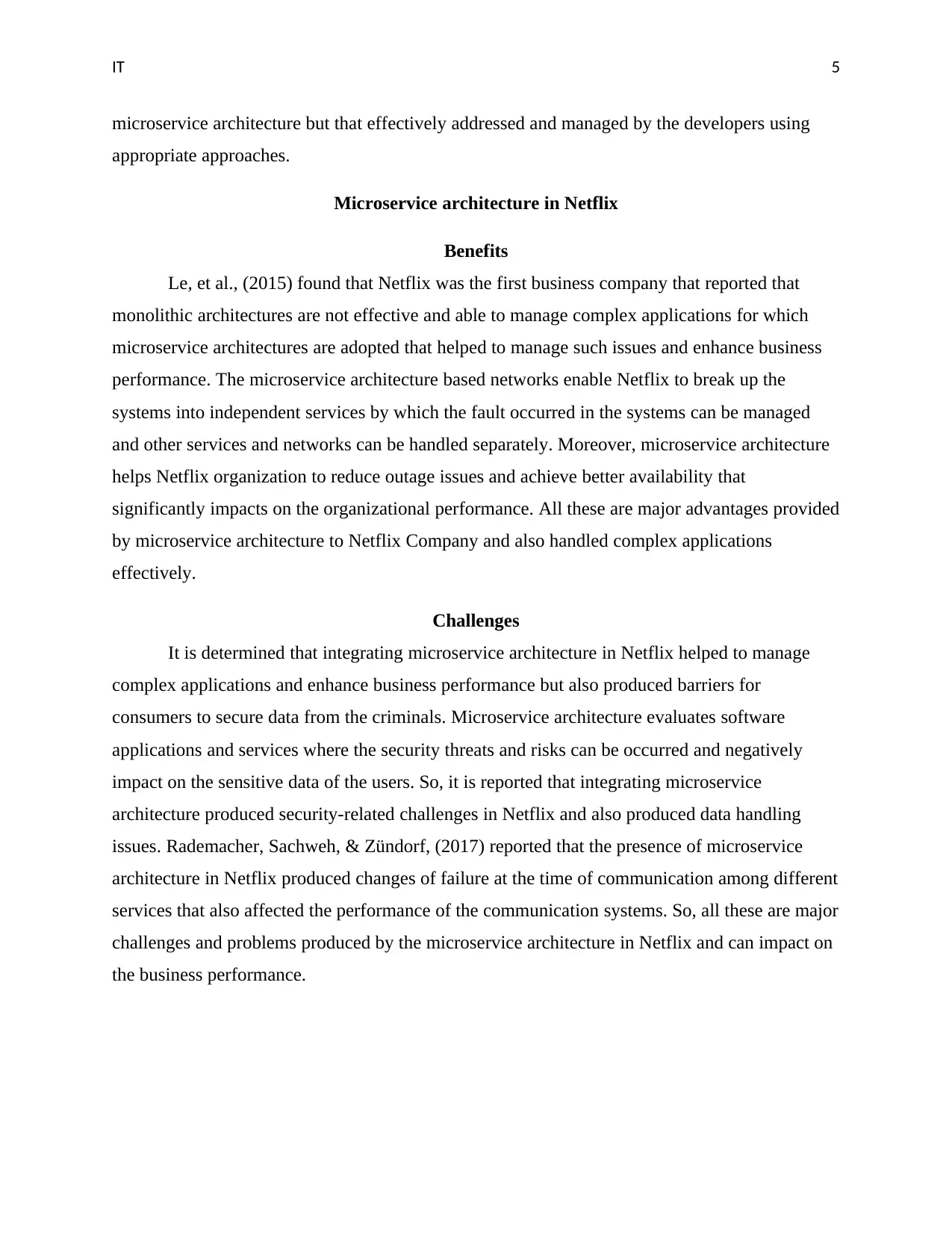
IT 5
microservice architecture but that effectively addressed and managed by the developers using
appropriate approaches.
Microservice architecture in Netflix
Benefits
Le, et al., (2015) found that Netflix was the first business company that reported that
monolithic architectures are not effective and able to manage complex applications for which
microservice architectures are adopted that helped to manage such issues and enhance business
performance. The microservice architecture based networks enable Netflix to break up the
systems into independent services by which the fault occurred in the systems can be managed
and other services and networks can be handled separately. Moreover, microservice architecture
helps Netflix organization to reduce outage issues and achieve better availability that
significantly impacts on the organizational performance. All these are major advantages provided
by microservice architecture to Netflix Company and also handled complex applications
effectively.
Challenges
It is determined that integrating microservice architecture in Netflix helped to manage
complex applications and enhance business performance but also produced barriers for
consumers to secure data from the criminals. Microservice architecture evaluates software
applications and services where the security threats and risks can be occurred and negatively
impact on the sensitive data of the users. So, it is reported that integrating microservice
architecture produced security-related challenges in Netflix and also produced data handling
issues. Rademacher, Sachweh, & Zündorf, (2017) reported that the presence of microservice
architecture in Netflix produced changes of failure at the time of communication among different
services that also affected the performance of the communication systems. So, all these are major
challenges and problems produced by the microservice architecture in Netflix and can impact on
the business performance.
microservice architecture but that effectively addressed and managed by the developers using
appropriate approaches.
Microservice architecture in Netflix
Benefits
Le, et al., (2015) found that Netflix was the first business company that reported that
monolithic architectures are not effective and able to manage complex applications for which
microservice architectures are adopted that helped to manage such issues and enhance business
performance. The microservice architecture based networks enable Netflix to break up the
systems into independent services by which the fault occurred in the systems can be managed
and other services and networks can be handled separately. Moreover, microservice architecture
helps Netflix organization to reduce outage issues and achieve better availability that
significantly impacts on the organizational performance. All these are major advantages provided
by microservice architecture to Netflix Company and also handled complex applications
effectively.
Challenges
It is determined that integrating microservice architecture in Netflix helped to manage
complex applications and enhance business performance but also produced barriers for
consumers to secure data from the criminals. Microservice architecture evaluates software
applications and services where the security threats and risks can be occurred and negatively
impact on the sensitive data of the users. So, it is reported that integrating microservice
architecture produced security-related challenges in Netflix and also produced data handling
issues. Rademacher, Sachweh, & Zündorf, (2017) reported that the presence of microservice
architecture in Netflix produced changes of failure at the time of communication among different
services that also affected the performance of the communication systems. So, all these are major
challenges and problems produced by the microservice architecture in Netflix and can impact on
the business performance.
⊘ This is a preview!⊘
Do you want full access?
Subscribe today to unlock all pages.

Trusted by 1+ million students worldwide
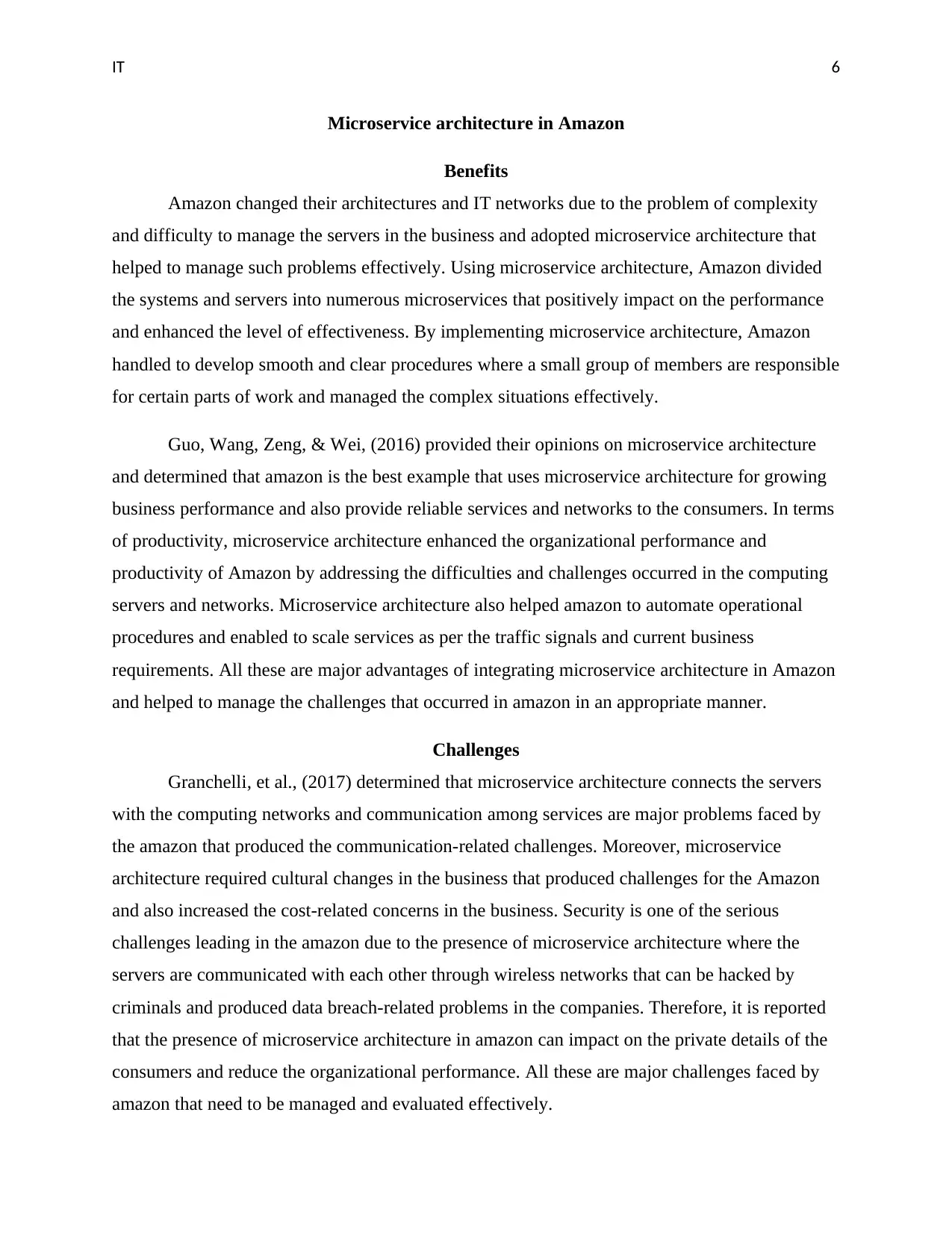
IT 6
Microservice architecture in Amazon
Benefits
Amazon changed their architectures and IT networks due to the problem of complexity
and difficulty to manage the servers in the business and adopted microservice architecture that
helped to manage such problems effectively. Using microservice architecture, Amazon divided
the systems and servers into numerous microservices that positively impact on the performance
and enhanced the level of effectiveness. By implementing microservice architecture, Amazon
handled to develop smooth and clear procedures where a small group of members are responsible
for certain parts of work and managed the complex situations effectively.
Guo, Wang, Zeng, & Wei, (2016) provided their opinions on microservice architecture
and determined that amazon is the best example that uses microservice architecture for growing
business performance and also provide reliable services and networks to the consumers. In terms
of productivity, microservice architecture enhanced the organizational performance and
productivity of Amazon by addressing the difficulties and challenges occurred in the computing
servers and networks. Microservice architecture also helped amazon to automate operational
procedures and enabled to scale services as per the traffic signals and current business
requirements. All these are major advantages of integrating microservice architecture in Amazon
and helped to manage the challenges that occurred in amazon in an appropriate manner.
Challenges
Granchelli, et al., (2017) determined that microservice architecture connects the servers
with the computing networks and communication among services are major problems faced by
the amazon that produced the communication-related challenges. Moreover, microservice
architecture required cultural changes in the business that produced challenges for the Amazon
and also increased the cost-related concerns in the business. Security is one of the serious
challenges leading in the amazon due to the presence of microservice architecture where the
servers are communicated with each other through wireless networks that can be hacked by
criminals and produced data breach-related problems in the companies. Therefore, it is reported
that the presence of microservice architecture in amazon can impact on the private details of the
consumers and reduce the organizational performance. All these are major challenges faced by
amazon that need to be managed and evaluated effectively.
Microservice architecture in Amazon
Benefits
Amazon changed their architectures and IT networks due to the problem of complexity
and difficulty to manage the servers in the business and adopted microservice architecture that
helped to manage such problems effectively. Using microservice architecture, Amazon divided
the systems and servers into numerous microservices that positively impact on the performance
and enhanced the level of effectiveness. By implementing microservice architecture, Amazon
handled to develop smooth and clear procedures where a small group of members are responsible
for certain parts of work and managed the complex situations effectively.
Guo, Wang, Zeng, & Wei, (2016) provided their opinions on microservice architecture
and determined that amazon is the best example that uses microservice architecture for growing
business performance and also provide reliable services and networks to the consumers. In terms
of productivity, microservice architecture enhanced the organizational performance and
productivity of Amazon by addressing the difficulties and challenges occurred in the computing
servers and networks. Microservice architecture also helped amazon to automate operational
procedures and enabled to scale services as per the traffic signals and current business
requirements. All these are major advantages of integrating microservice architecture in Amazon
and helped to manage the challenges that occurred in amazon in an appropriate manner.
Challenges
Granchelli, et al., (2017) determined that microservice architecture connects the servers
with the computing networks and communication among services are major problems faced by
the amazon that produced the communication-related challenges. Moreover, microservice
architecture required cultural changes in the business that produced challenges for the Amazon
and also increased the cost-related concerns in the business. Security is one of the serious
challenges leading in the amazon due to the presence of microservice architecture where the
servers are communicated with each other through wireless networks that can be hacked by
criminals and produced data breach-related problems in the companies. Therefore, it is reported
that the presence of microservice architecture in amazon can impact on the private details of the
consumers and reduce the organizational performance. All these are major challenges faced by
amazon that need to be managed and evaluated effectively.
Paraphrase This Document
Need a fresh take? Get an instant paraphrase of this document with our AI Paraphraser
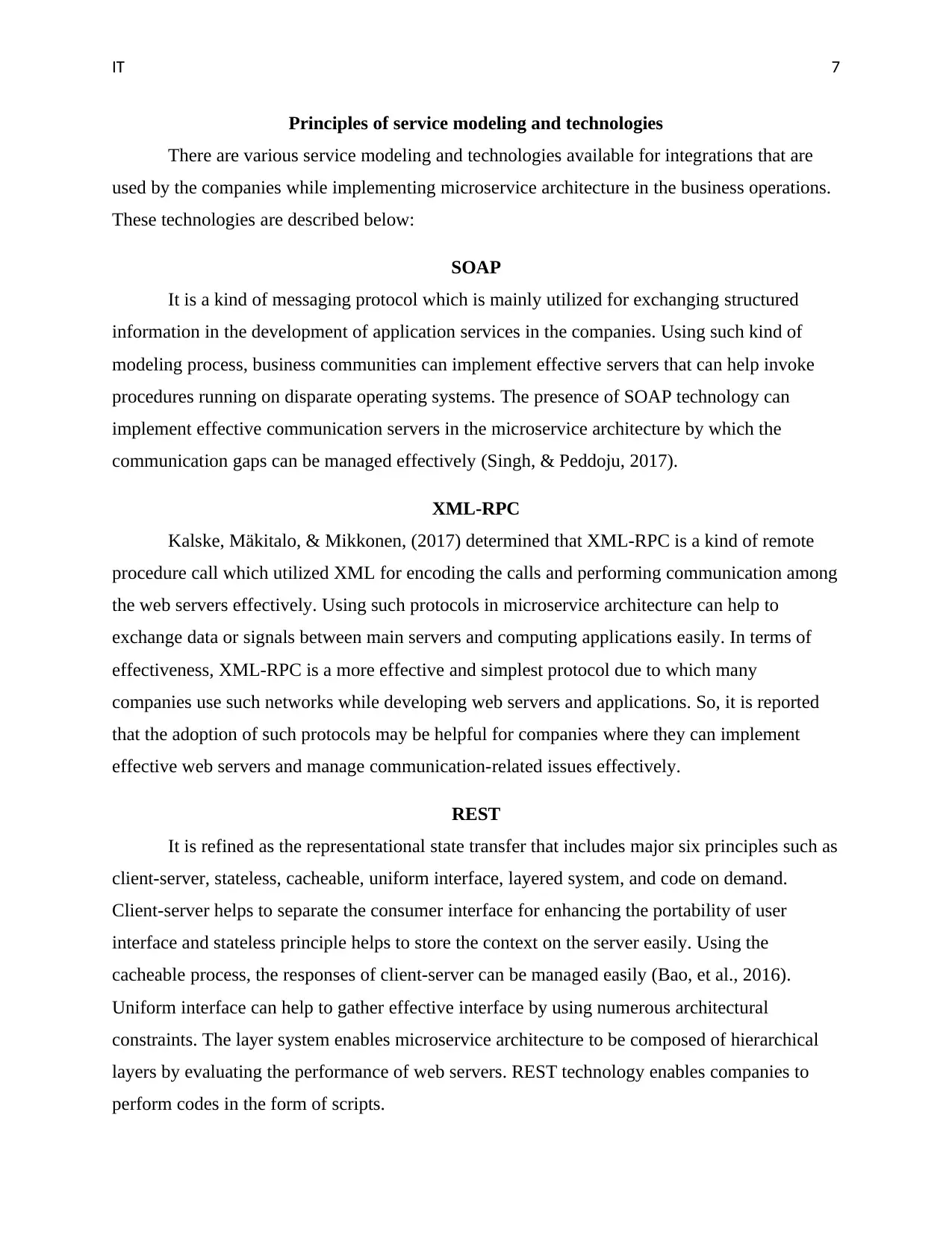
IT 7
Principles of service modeling and technologies
There are various service modeling and technologies available for integrations that are
used by the companies while implementing microservice architecture in the business operations.
These technologies are described below:
SOAP
It is a kind of messaging protocol which is mainly utilized for exchanging structured
information in the development of application services in the companies. Using such kind of
modeling process, business communities can implement effective servers that can help invoke
procedures running on disparate operating systems. The presence of SOAP technology can
implement effective communication servers in the microservice architecture by which the
communication gaps can be managed effectively (Singh, & Peddoju, 2017).
XML-RPC
Kalske, Mäkitalo, & Mikkonen, (2017) determined that XML-RPC is a kind of remote
procedure call which utilized XML for encoding the calls and performing communication among
the web servers effectively. Using such protocols in microservice architecture can help to
exchange data or signals between main servers and computing applications easily. In terms of
effectiveness, XML-RPC is a more effective and simplest protocol due to which many
companies use such networks while developing web servers and applications. So, it is reported
that the adoption of such protocols may be helpful for companies where they can implement
effective web servers and manage communication-related issues effectively.
REST
It is refined as the representational state transfer that includes major six principles such as
client-server, stateless, cacheable, uniform interface, layered system, and code on demand.
Client-server helps to separate the consumer interface for enhancing the portability of user
interface and stateless principle helps to store the context on the server easily. Using the
cacheable process, the responses of client-server can be managed easily (Bao, et al., 2016).
Uniform interface can help to gather effective interface by using numerous architectural
constraints. The layer system enables microservice architecture to be composed of hierarchical
layers by evaluating the performance of web servers. REST technology enables companies to
perform codes in the form of scripts.
Principles of service modeling and technologies
There are various service modeling and technologies available for integrations that are
used by the companies while implementing microservice architecture in the business operations.
These technologies are described below:
SOAP
It is a kind of messaging protocol which is mainly utilized for exchanging structured
information in the development of application services in the companies. Using such kind of
modeling process, business communities can implement effective servers that can help invoke
procedures running on disparate operating systems. The presence of SOAP technology can
implement effective communication servers in the microservice architecture by which the
communication gaps can be managed effectively (Singh, & Peddoju, 2017).
XML-RPC
Kalske, Mäkitalo, & Mikkonen, (2017) determined that XML-RPC is a kind of remote
procedure call which utilized XML for encoding the calls and performing communication among
the web servers effectively. Using such protocols in microservice architecture can help to
exchange data or signals between main servers and computing applications easily. In terms of
effectiveness, XML-RPC is a more effective and simplest protocol due to which many
companies use such networks while developing web servers and applications. So, it is reported
that the adoption of such protocols may be helpful for companies where they can implement
effective web servers and manage communication-related issues effectively.
REST
It is refined as the representational state transfer that includes major six principles such as
client-server, stateless, cacheable, uniform interface, layered system, and code on demand.
Client-server helps to separate the consumer interface for enhancing the portability of user
interface and stateless principle helps to store the context on the server easily. Using the
cacheable process, the responses of client-server can be managed easily (Bao, et al., 2016).
Uniform interface can help to gather effective interface by using numerous architectural
constraints. The layer system enables microservice architecture to be composed of hierarchical
layers by evaluating the performance of web servers. REST technology enables companies to
perform codes in the form of scripts.
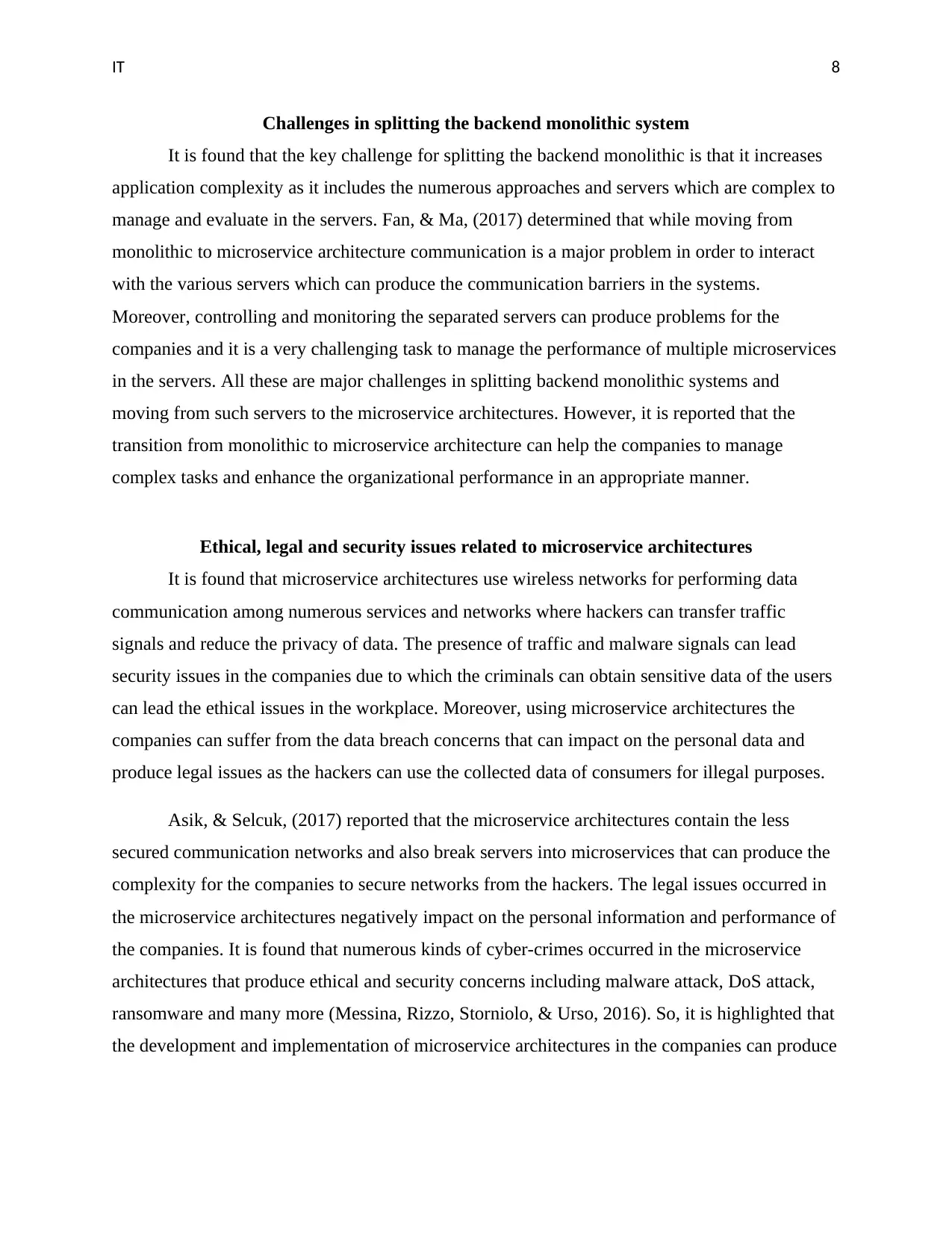
IT 8
Challenges in splitting the backend monolithic system
It is found that the key challenge for splitting the backend monolithic is that it increases
application complexity as it includes the numerous approaches and servers which are complex to
manage and evaluate in the servers. Fan, & Ma, (2017) determined that while moving from
monolithic to microservice architecture communication is a major problem in order to interact
with the various servers which can produce the communication barriers in the systems.
Moreover, controlling and monitoring the separated servers can produce problems for the
companies and it is a very challenging task to manage the performance of multiple microservices
in the servers. All these are major challenges in splitting backend monolithic systems and
moving from such servers to the microservice architectures. However, it is reported that the
transition from monolithic to microservice architecture can help the companies to manage
complex tasks and enhance the organizational performance in an appropriate manner.
Ethical, legal and security issues related to microservice architectures
It is found that microservice architectures use wireless networks for performing data
communication among numerous services and networks where hackers can transfer traffic
signals and reduce the privacy of data. The presence of traffic and malware signals can lead
security issues in the companies due to which the criminals can obtain sensitive data of the users
can lead the ethical issues in the workplace. Moreover, using microservice architectures the
companies can suffer from the data breach concerns that can impact on the personal data and
produce legal issues as the hackers can use the collected data of consumers for illegal purposes.
Asik, & Selcuk, (2017) reported that the microservice architectures contain the less
secured communication networks and also break servers into microservices that can produce the
complexity for the companies to secure networks from the hackers. The legal issues occurred in
the microservice architectures negatively impact on the personal information and performance of
the companies. It is found that numerous kinds of cyber-crimes occurred in the microservice
architectures that produce ethical and security concerns including malware attack, DoS attack,
ransomware and many more (Messina, Rizzo, Storniolo, & Urso, 2016). So, it is highlighted that
the development and implementation of microservice architectures in the companies can produce
Challenges in splitting the backend monolithic system
It is found that the key challenge for splitting the backend monolithic is that it increases
application complexity as it includes the numerous approaches and servers which are complex to
manage and evaluate in the servers. Fan, & Ma, (2017) determined that while moving from
monolithic to microservice architecture communication is a major problem in order to interact
with the various servers which can produce the communication barriers in the systems.
Moreover, controlling and monitoring the separated servers can produce problems for the
companies and it is a very challenging task to manage the performance of multiple microservices
in the servers. All these are major challenges in splitting backend monolithic systems and
moving from such servers to the microservice architectures. However, it is reported that the
transition from monolithic to microservice architecture can help the companies to manage
complex tasks and enhance the organizational performance in an appropriate manner.
Ethical, legal and security issues related to microservice architectures
It is found that microservice architectures use wireless networks for performing data
communication among numerous services and networks where hackers can transfer traffic
signals and reduce the privacy of data. The presence of traffic and malware signals can lead
security issues in the companies due to which the criminals can obtain sensitive data of the users
can lead the ethical issues in the workplace. Moreover, using microservice architectures the
companies can suffer from the data breach concerns that can impact on the personal data and
produce legal issues as the hackers can use the collected data of consumers for illegal purposes.
Asik, & Selcuk, (2017) reported that the microservice architectures contain the less
secured communication networks and also break servers into microservices that can produce the
complexity for the companies to secure networks from the hackers. The legal issues occurred in
the microservice architectures negatively impact on the personal information and performance of
the companies. It is found that numerous kinds of cyber-crimes occurred in the microservice
architectures that produce ethical and security concerns including malware attack, DoS attack,
ransomware and many more (Messina, Rizzo, Storniolo, & Urso, 2016). So, it is highlighted that
the development and implementation of microservice architectures in the companies can produce
⊘ This is a preview!⊘
Do you want full access?
Subscribe today to unlock all pages.

Trusted by 1+ million students worldwide
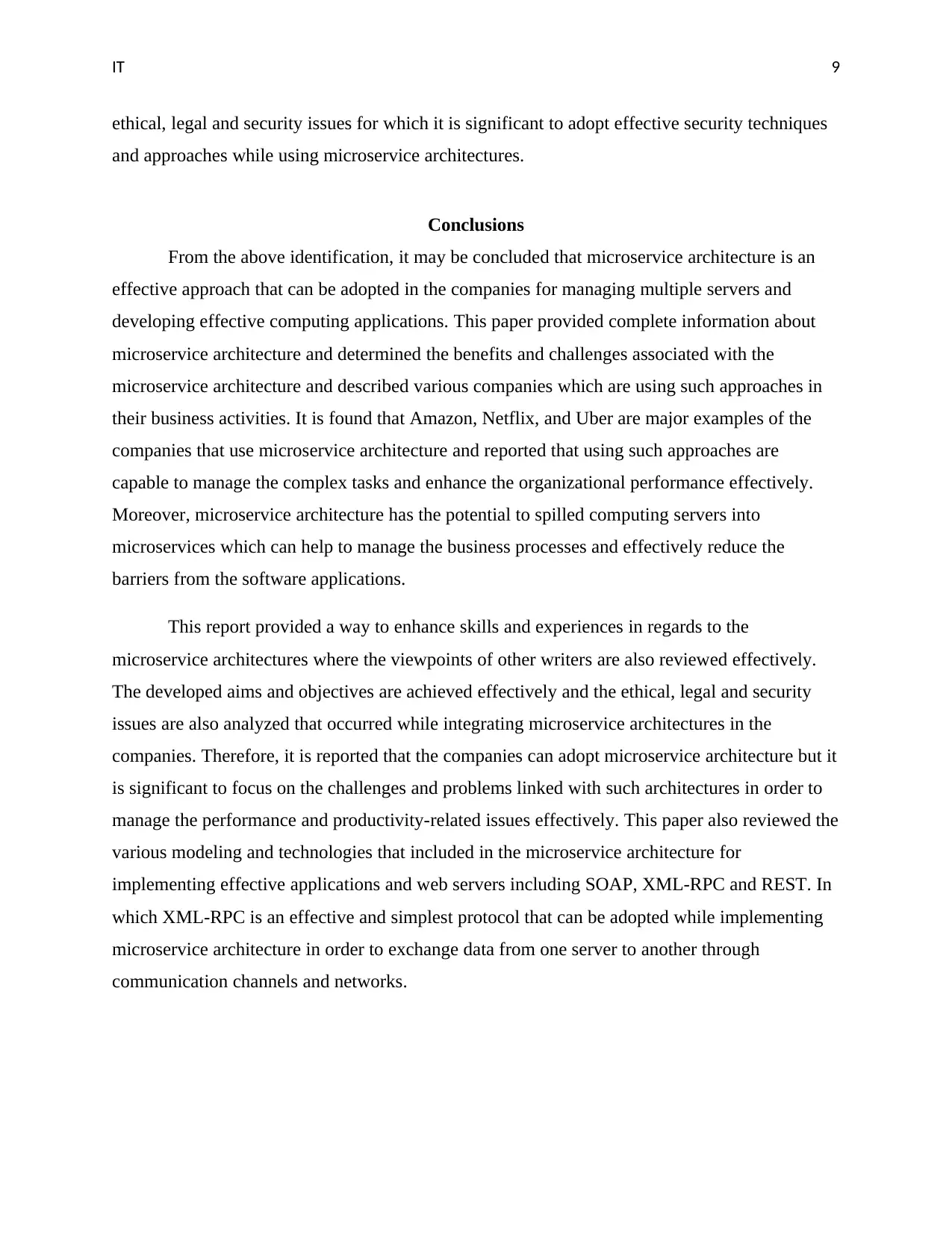
IT 9
ethical, legal and security issues for which it is significant to adopt effective security techniques
and approaches while using microservice architectures.
Conclusions
From the above identification, it may be concluded that microservice architecture is an
effective approach that can be adopted in the companies for managing multiple servers and
developing effective computing applications. This paper provided complete information about
microservice architecture and determined the benefits and challenges associated with the
microservice architecture and described various companies which are using such approaches in
their business activities. It is found that Amazon, Netflix, and Uber are major examples of the
companies that use microservice architecture and reported that using such approaches are
capable to manage the complex tasks and enhance the organizational performance effectively.
Moreover, microservice architecture has the potential to spilled computing servers into
microservices which can help to manage the business processes and effectively reduce the
barriers from the software applications.
This report provided a way to enhance skills and experiences in regards to the
microservice architectures where the viewpoints of other writers are also reviewed effectively.
The developed aims and objectives are achieved effectively and the ethical, legal and security
issues are also analyzed that occurred while integrating microservice architectures in the
companies. Therefore, it is reported that the companies can adopt microservice architecture but it
is significant to focus on the challenges and problems linked with such architectures in order to
manage the performance and productivity-related issues effectively. This paper also reviewed the
various modeling and technologies that included in the microservice architecture for
implementing effective applications and web servers including SOAP, XML-RPC and REST. In
which XML-RPC is an effective and simplest protocol that can be adopted while implementing
microservice architecture in order to exchange data from one server to another through
communication channels and networks.
ethical, legal and security issues for which it is significant to adopt effective security techniques
and approaches while using microservice architectures.
Conclusions
From the above identification, it may be concluded that microservice architecture is an
effective approach that can be adopted in the companies for managing multiple servers and
developing effective computing applications. This paper provided complete information about
microservice architecture and determined the benefits and challenges associated with the
microservice architecture and described various companies which are using such approaches in
their business activities. It is found that Amazon, Netflix, and Uber are major examples of the
companies that use microservice architecture and reported that using such approaches are
capable to manage the complex tasks and enhance the organizational performance effectively.
Moreover, microservice architecture has the potential to spilled computing servers into
microservices which can help to manage the business processes and effectively reduce the
barriers from the software applications.
This report provided a way to enhance skills and experiences in regards to the
microservice architectures where the viewpoints of other writers are also reviewed effectively.
The developed aims and objectives are achieved effectively and the ethical, legal and security
issues are also analyzed that occurred while integrating microservice architectures in the
companies. Therefore, it is reported that the companies can adopt microservice architecture but it
is significant to focus on the challenges and problems linked with such architectures in order to
manage the performance and productivity-related issues effectively. This paper also reviewed the
various modeling and technologies that included in the microservice architecture for
implementing effective applications and web servers including SOAP, XML-RPC and REST. In
which XML-RPC is an effective and simplest protocol that can be adopted while implementing
microservice architecture in order to exchange data from one server to another through
communication channels and networks.
Paraphrase This Document
Need a fresh take? Get an instant paraphrase of this document with our AI Paraphraser
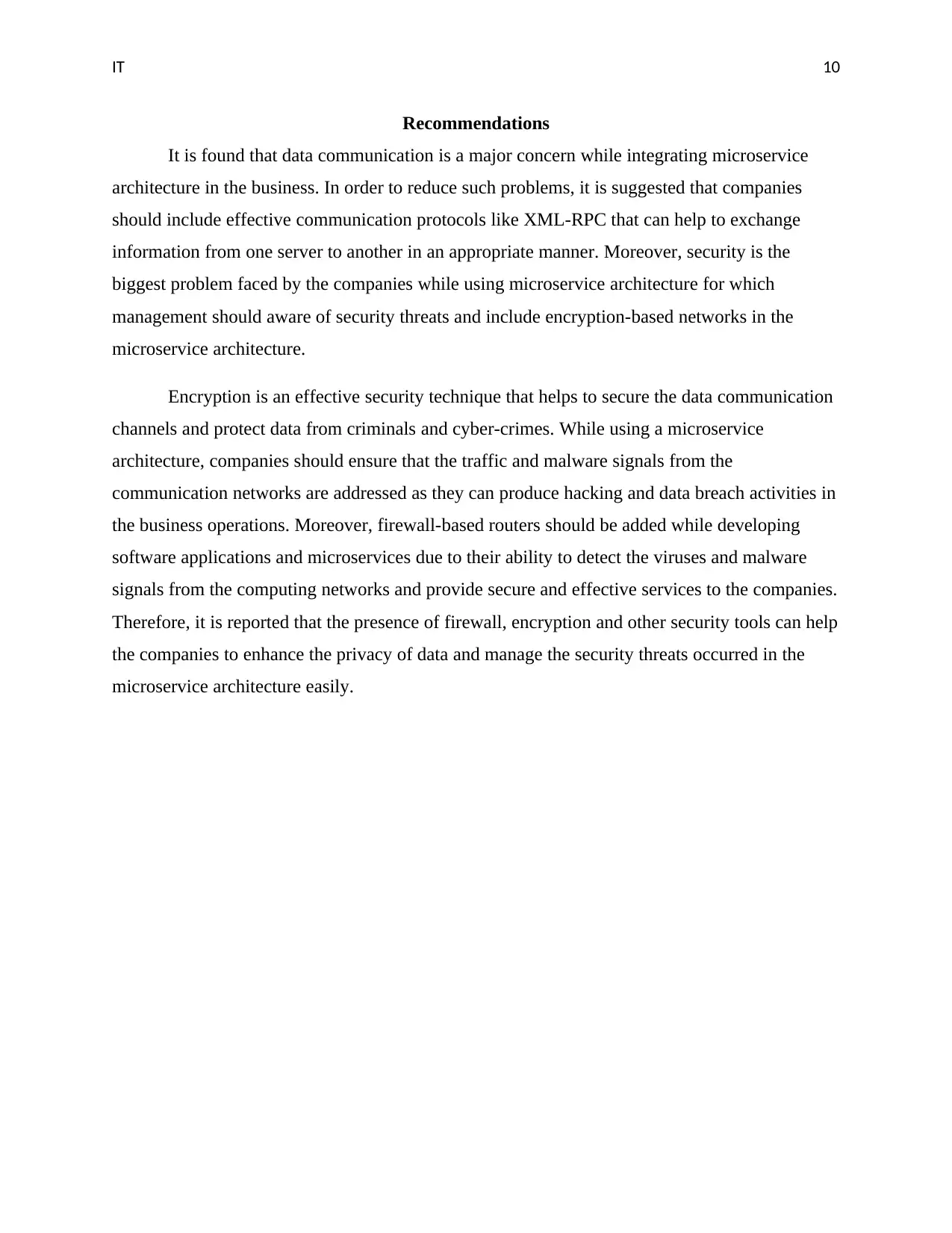
IT 10
Recommendations
It is found that data communication is a major concern while integrating microservice
architecture in the business. In order to reduce such problems, it is suggested that companies
should include effective communication protocols like XML-RPC that can help to exchange
information from one server to another in an appropriate manner. Moreover, security is the
biggest problem faced by the companies while using microservice architecture for which
management should aware of security threats and include encryption-based networks in the
microservice architecture.
Encryption is an effective security technique that helps to secure the data communication
channels and protect data from criminals and cyber-crimes. While using a microservice
architecture, companies should ensure that the traffic and malware signals from the
communication networks are addressed as they can produce hacking and data breach activities in
the business operations. Moreover, firewall-based routers should be added while developing
software applications and microservices due to their ability to detect the viruses and malware
signals from the computing networks and provide secure and effective services to the companies.
Therefore, it is reported that the presence of firewall, encryption and other security tools can help
the companies to enhance the privacy of data and manage the security threats occurred in the
microservice architecture easily.
Recommendations
It is found that data communication is a major concern while integrating microservice
architecture in the business. In order to reduce such problems, it is suggested that companies
should include effective communication protocols like XML-RPC that can help to exchange
information from one server to another in an appropriate manner. Moreover, security is the
biggest problem faced by the companies while using microservice architecture for which
management should aware of security threats and include encryption-based networks in the
microservice architecture.
Encryption is an effective security technique that helps to secure the data communication
channels and protect data from criminals and cyber-crimes. While using a microservice
architecture, companies should ensure that the traffic and malware signals from the
communication networks are addressed as they can produce hacking and data breach activities in
the business operations. Moreover, firewall-based routers should be added while developing
software applications and microservices due to their ability to detect the viruses and malware
signals from the computing networks and provide secure and effective services to the companies.
Therefore, it is reported that the presence of firewall, encryption and other security tools can help
the companies to enhance the privacy of data and manage the security threats occurred in the
microservice architecture easily.
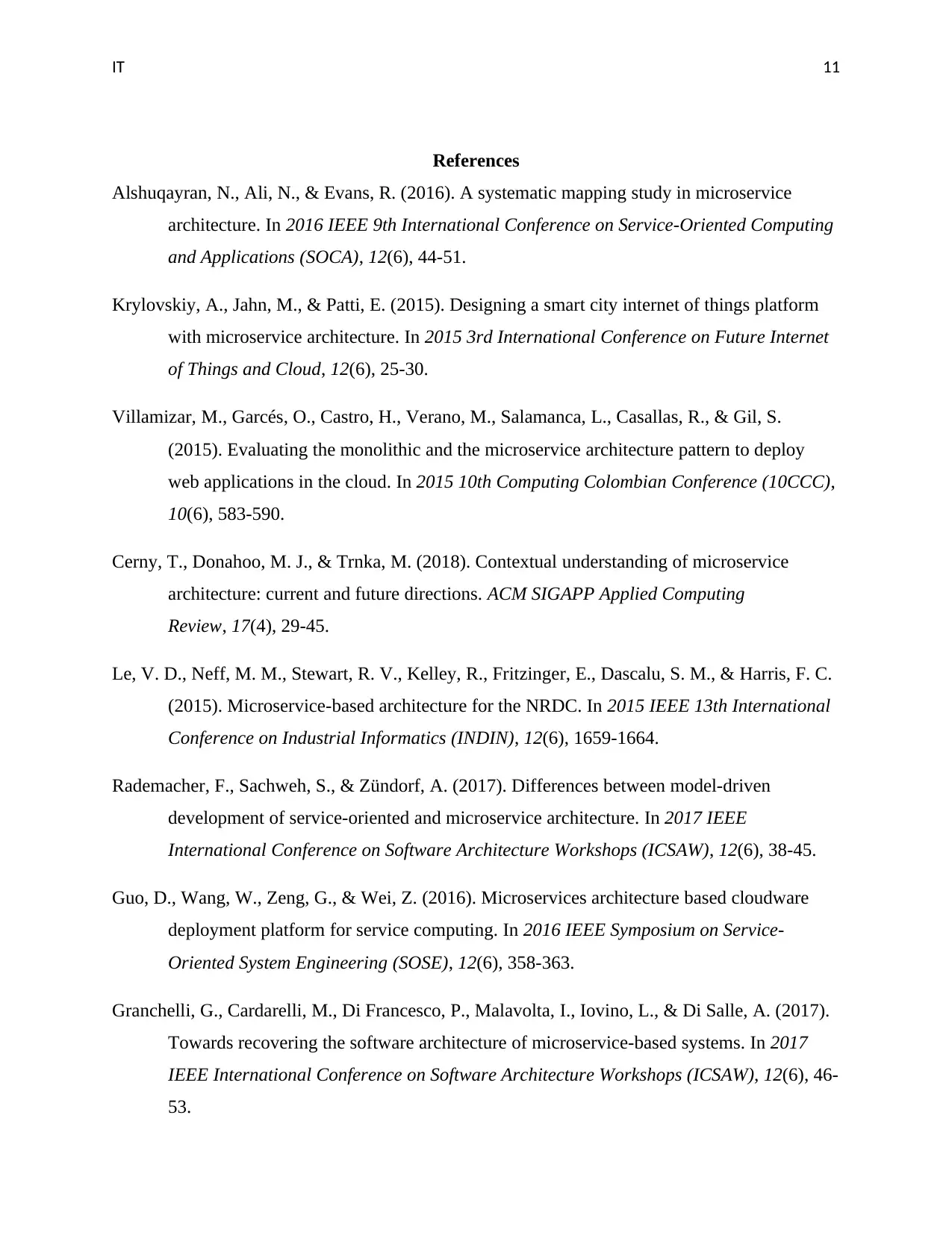
IT 11
References
Alshuqayran, N., Ali, N., & Evans, R. (2016). A systematic mapping study in microservice
architecture. In 2016 IEEE 9th International Conference on Service-Oriented Computing
and Applications (SOCA), 12(6), 44-51.
Krylovskiy, A., Jahn, M., & Patti, E. (2015). Designing a smart city internet of things platform
with microservice architecture. In 2015 3rd International Conference on Future Internet
of Things and Cloud, 12(6), 25-30.
Villamizar, M., Garcés, O., Castro, H., Verano, M., Salamanca, L., Casallas, R., & Gil, S.
(2015). Evaluating the monolithic and the microservice architecture pattern to deploy
web applications in the cloud. In 2015 10th Computing Colombian Conference (10CCC),
10(6), 583-590.
Cerny, T., Donahoo, M. J., & Trnka, M. (2018). Contextual understanding of microservice
architecture: current and future directions. ACM SIGAPP Applied Computing
Review, 17(4), 29-45.
Le, V. D., Neff, M. M., Stewart, R. V., Kelley, R., Fritzinger, E., Dascalu, S. M., & Harris, F. C.
(2015). Microservice-based architecture for the NRDC. In 2015 IEEE 13th International
Conference on Industrial Informatics (INDIN), 12(6), 1659-1664.
Rademacher, F., Sachweh, S., & Zündorf, A. (2017). Differences between model-driven
development of service-oriented and microservice architecture. In 2017 IEEE
International Conference on Software Architecture Workshops (ICSAW), 12(6), 38-45.
Guo, D., Wang, W., Zeng, G., & Wei, Z. (2016). Microservices architecture based cloudware
deployment platform for service computing. In 2016 IEEE Symposium on Service-
Oriented System Engineering (SOSE), 12(6), 358-363.
Granchelli, G., Cardarelli, M., Di Francesco, P., Malavolta, I., Iovino, L., & Di Salle, A. (2017).
Towards recovering the software architecture of microservice-based systems. In 2017
IEEE International Conference on Software Architecture Workshops (ICSAW), 12(6), 46-
53.
References
Alshuqayran, N., Ali, N., & Evans, R. (2016). A systematic mapping study in microservice
architecture. In 2016 IEEE 9th International Conference on Service-Oriented Computing
and Applications (SOCA), 12(6), 44-51.
Krylovskiy, A., Jahn, M., & Patti, E. (2015). Designing a smart city internet of things platform
with microservice architecture. In 2015 3rd International Conference on Future Internet
of Things and Cloud, 12(6), 25-30.
Villamizar, M., Garcés, O., Castro, H., Verano, M., Salamanca, L., Casallas, R., & Gil, S.
(2015). Evaluating the monolithic and the microservice architecture pattern to deploy
web applications in the cloud. In 2015 10th Computing Colombian Conference (10CCC),
10(6), 583-590.
Cerny, T., Donahoo, M. J., & Trnka, M. (2018). Contextual understanding of microservice
architecture: current and future directions. ACM SIGAPP Applied Computing
Review, 17(4), 29-45.
Le, V. D., Neff, M. M., Stewart, R. V., Kelley, R., Fritzinger, E., Dascalu, S. M., & Harris, F. C.
(2015). Microservice-based architecture for the NRDC. In 2015 IEEE 13th International
Conference on Industrial Informatics (INDIN), 12(6), 1659-1664.
Rademacher, F., Sachweh, S., & Zündorf, A. (2017). Differences between model-driven
development of service-oriented and microservice architecture. In 2017 IEEE
International Conference on Software Architecture Workshops (ICSAW), 12(6), 38-45.
Guo, D., Wang, W., Zeng, G., & Wei, Z. (2016). Microservices architecture based cloudware
deployment platform for service computing. In 2016 IEEE Symposium on Service-
Oriented System Engineering (SOSE), 12(6), 358-363.
Granchelli, G., Cardarelli, M., Di Francesco, P., Malavolta, I., Iovino, L., & Di Salle, A. (2017).
Towards recovering the software architecture of microservice-based systems. In 2017
IEEE International Conference on Software Architecture Workshops (ICSAW), 12(6), 46-
53.
⊘ This is a preview!⊘
Do you want full access?
Subscribe today to unlock all pages.

Trusted by 1+ million students worldwide
1 out of 13
Related Documents
Your All-in-One AI-Powered Toolkit for Academic Success.
+13062052269
info@desklib.com
Available 24*7 on WhatsApp / Email
![[object Object]](/_next/static/media/star-bottom.7253800d.svg)
Unlock your academic potential
Copyright © 2020–2025 A2Z Services. All Rights Reserved. Developed and managed by ZUCOL.





